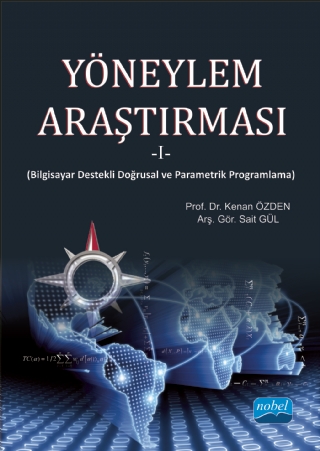Science and Mathematics \ 3-3

This book has been prepared for students studying in universities and military schools, especially in the departments of Industrial, Business and Systems engineering, and in departments such as Business Administration, Economics, Econometrics and Mathematics. The aim of the book is to provide the students with the opportunity of a textbook, where they can learn quantitative models and techniques that will help them in solving the decision-making problems they will encounter in the effective, economic and efficient use of resources such as people, materials and machinery in school and future business life.
One of the most important features of this book is that each subject is illustrated with a large number of problem solutions and computer applications are made with QM software at the end of the chapters, again with plenty of examples.
The book is the continuation and complement of our book titled “OPERATIONAL RESEARCH-I Computer Aided Linear and Parametric Programming”, volume 1, and includes computer aided solution examples of decision-making problems that may be encountered in industry and service enterprises, public institutions and the armed forces.
Network Analysis and Project Management Techniques, Integer Programming, Multicriteria Decision Making, Multi-Objective Decision Making (Goal Programming), Decision Theory, Game Theory, Nonlinear Programming and Markov Chains are included in the book as 8 chapters.
One of the most important features of this book is that each subject is illustrated with a large number of problem solutions and computer applications are made with QM software at the end of the chapters, again with plenty of examples.
The book is the continuation and complement of our book titled “OPERATIONAL RESEARCH-I Computer Aided Linear and Parametric Programming”, volume 1, and includes computer aided solution examples of decision-making problems that may be encountered in industry and service enterprises, public institutions and the armed forces.
Network Analysis and Project Management Techniques, Integer Programming, Multicriteria Decision Making, Multi-Objective Decision Making (Goal Programming), Decision Theory, Game Theory, Nonlinear Programming and Markov Chains are included in the book as 8 chapters.

The purpose of this book is to help students studying in the departments of Industrial, Business and Systems Engineering, Business Administration, Economics, Econometrics and Mathematics in universities and Military Academy, regarding the effective, economic and efficient use of resources such as human, material and machinery for business purposes in their working lives, is to provide the opportunity of a textbook or a supplementary textbook where they can learn quantitative models and techniques that will help them in solving the problems they will encounter in system and process design, planning, control, problem solving and decision making.
Operations Research, especially II. Since it found its first applications in solving military problems during World War II, it is an important decision-making tool for the management of the Armed Forces as well as in the management of enterprises and other organizations. In this respect, in addition to respecting the military origin of this field of science, considering that the book can also be used as a course aid in the Military Academy, military example problems and concepts are included from time to time as well as sample business problems.
Operations Research, especially II. Since it found its first applications in solving military problems during World War II, it is an important decision-making tool for the management of the Armed Forces as well as in the management of enterprises and other organizations. In this respect, in addition to respecting the military origin of this field of science, considering that the book can also be used as a course aid in the Military Academy, military example problems and concepts are included from time to time as well as sample business problems.

In the book named Time Series and Forecasting Methods; All forecasting methods, from basic to advanced, are introduced with R applications. The book has been prepared with the intention of being a bedside book for researchers who want to train themselves as predictors and practitioners who need foresight methods. In the book, subject introductions are tried to be given by creating a good balance of theory and practice. In addition to the classical prediction methods, popular methods such as artificial neural networks and deep learning methods as artificial intelligence prediction methods have also found their place in the content of the book. R applications of all the methods given in the book were carried out. Practitioners benefiting from the book will have the ability to use the automatic prediction methods included in the R program. It is a book for undergraduate, graduate and doctoral students in Statistics, Business Administration, Industrial Engineering, Data Science, Computer Engineering and Economics.

Zoology course is the most basic course for all biologists. During the undergraduate education, zoology will be used in all the courses to be studied, and the requirements for a better understanding of this course will increase. In the book prepared to meet this need, zoology in general terms; cell and tissue systems and the structuring of tissues are discussed on the basis of embryological development. Under thirteen chapters in total; disciplines in biology, ways of examining biological events, cell and cell science, cell elements, functions of the nucleus, reproduction-reproduction, embryology, organization-histology in living things, organs and systems, diversity of life, ecology and behavior are discussed. Biodiversity is given as an introduction to the information to be obtained in the systematics of invertebrate and vertebrate groups, and ecology and behavior issues form a preliminary information for the following years.
Working with the third edition is for biologists and anyone interested in biology; It will be useful because it provides the opportunity to meet with biology and convey the basic subjects in an understandable language.
Working with the third edition is for biologists and anyone interested in biology; It will be useful because it provides the opportunity to meet with biology and convey the basic subjects in an understandable language.